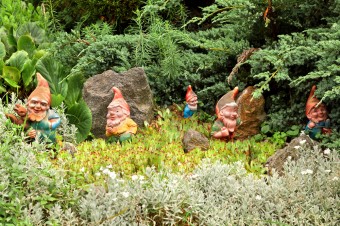How the Tradition of Putting a Gnome in Your Garden Started
 Garden gnomes are those statues you see of pint sized chubby human-like creatures usually wearing red hats and blue pants. You can find them in a variety of poses and pursuing various past times such as fishing, napping, or in the case of my personal gnome, smoking a pipe. Garden gnomes are typically male and have beards but you see the occasional female gnome statue these days.
Garden gnomes are those statues you see of pint sized chubby human-like creatures usually wearing red hats and blue pants. You can find them in a variety of poses and pursuing various past times such as fishing, napping, or in the case of my personal gnome, smoking a pipe. Garden gnomes are typically male and have beards but you see the occasional female gnome statue these days.
While it took longer to catch on in the United States, garden statuary has been popular in European countries since at least the Renaissance. Saints, gods and mythical creatures were among the early figures depicted, and one character called Gobbi, which is Italian for “dwarf” or “hunchback”, starting in the early 1600s.
From there, references of “House Dwarves” are found in the late 1700s. These statues were made of porcelain and produced continuously through the 19th Century. It is believed the dwarves morphed into gnomes and moved from the house to the garden when Baehr and Maresch out of Dresden, Germany started producing their own take on the dwarves around 1841.
Sir Charles Isham was also a key figure in the spreading of the gnome, when he introduced gnomes to the United Kingdom by bringing 21 of the terracotta figures home with him from a trip to Germany around 1847 and placed them in the garden of his home. (Amazingly, one of those original gnomes is still around. Lampy, as the statue is called, is on display at Isham’s home, Lamport Hall.)
Within a couple decades of Sir Isham’s trip, garden gnomes began being strongly associated with Gräfenroda, Germany, a region famous for its ceramics. The two biggest players in the industry there were August Heissner and Philip Griebel (with the Griebel company still producing the gnomes to this day).
Griebel originally specialized in decorative terracotta animals but branched out to produce gnomes based on existing local myths about the creatures. These legendary magic using gnomes were said to be earth elementals (hence their placement in gardens) who lived underground in the daylight where they guarded their treasures, and would emerge at night. If they were caught out in daylight, they’d turn to stone, which of course lends itself to the idea of the garden gnome statues.
Thanks largely to Heissner and Griebel’s designs, the garden gnome’s popularity quickly spread across Germany and Europe and then the world.
Besides just sticking the Gnomes in a garden, another modern Gnome “tradition” has recently popped up- Gnome-napping. Essentially, you steal someone’s garden gnome, then take it on a trip or other sort of adventure while taking lots of pictures of what the gnome’s been up to on its journey and send them back to the owner. If you choose, when you’re done, you return the gnome to where it started. This practice seems to have started in the 1980s in Australia, but saw a huge upswing in popularity thanks to the 5 time Academy Award nominated 2001 film Amelie where this is depicted.
If you liked this article, you might also enjoy our new popular podcast, The BrainFood Show (iTunes, Spotify, Google Play Music, Feed), as well as:
- When a Tulip Cost More Than a House
- How a Wife Beating, Serial Killer Puppet Gave Us the Expression “Pleased as Punch”
- The Fascinating Origins of the Neck Tie
- Why the Oscars are Called the Oscars
- The Story Behind the Morton’s Salt Girl
Bonus Fact:
- Popular or not, garden gnomes and their owners have faced persecution through the years. In 2006, the Royal Horticulture Society of Britain banned the use of “brightly colored creatures” in landscaping for the Chelsea Flower Show, considered to be the gardening world’s equivalent to the Kentucky Derby. Unfortunately, the ban applied to gnomes. Show organizers claim the decorations detract from garden designs, but gnome supporters say it’s a case of snobbery because the gnomes are popular and common in the gardens of working class people.
| Share the Knowledge! |
|





The origin of the humble garden gnome may date back even further. Some believe the inspiration for their creation can be traced back all the way to ancient Rome.
For the record, the Italian word “Gobbi” is the plural of “Gobba” which translates directly to “Hump”.
A “Gobbo” is a hunchback, a person with a hump on their back or a Hunchback. “Gobbi” is simply the plural of the term describing persons with a hunchback. The plural of Hump would be “Gobbe” since “Gobba” is a female noun while “I gobbi” is intended to refer to make hunchbacks. For female hunchbacks the term would be “le Gobbe” and one would tell the difference between referring to a number of disembodied “humps” or a number of female hunchbacks only by placing them in context.
Things like these make me wonder how anyone learns to speak Italian.
To recap:
Gobba : hunch or a female person with a hunchback
Gobbe: several hunches or several female persons with a hunchback
Gobbo: A singular, male person with a hunchback
Gobbi: several male hunchbacks.
Incidentally, “Gnomes” are called “Nani” (nano being the singular male form, Nana, the singular female, Nani the plural male and nane the plural feminine.
Also one can use the word Gnomo (gnomo, gnomi, gnoma, gnome properly conjugated by gender and quantity).
It is exhausting isn’t it?